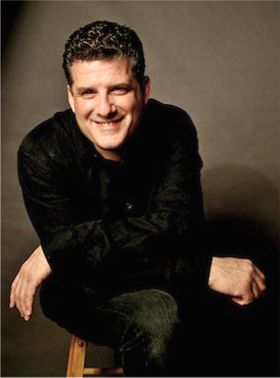|

Original
cover of Dan Pulcrano's 1993 paper
warning fellow newspaper publishers about the
challenges they would face from the Internet
(they
not only ignored him, they kicked him off their
board!) |
But
Pulcrano saw much more than just the increasing
value of domain names. Back in 1993, when he was
already a successful publisher of alternative newspapers,
Pulcrano saw and warned his colleagues about the print
media train wreck that we are seeing play out before
our eyes today. On Oct. 27, 1993, Pulcrano wrote a
private paper called The Alternative Press at the
Crossroads: Will We Be Players in the New
Information Age Or Road Kill on the Digital Highway
and sent it to fellow board members of his industry trade
group (the Association of Alternative Newsweeklies). About
the Internet, Pulcrano wrote this, "The
biggest area of competition for the alternative press, at
the user information level, will be at the back of the
book: music, movie and event listings, classified
advertising and personals. While print offers many
user-friendly advantages to electronic technologies and
will likely remain the dominant player for at least the
next decade, we can expect to see a gradual erosion
in the percentage of readers who rely on print exclusively
for these categories of information - particularly as
portable wireless devices begin to proliferate and
screen technologies cross the 2,000-pixel threshold, at
which point electronic resolution will overtake print
in terms of readability and resolution." |
The accuracy of his comments,
especially in view of the fact that they were written 15 years
ago, is uncanny to say the least. Here's another passage that is
even more compelling - "In terms of advertising, we will
likely see a migration (to the web) of classified and
personal advertising, along with the introduction of
"electronic yellow pages" type services. The
electronic medium offers several advantages to print:
instant search capabilities based on predetermined criteria,
direct placement of ads by readers, instant updating, and the
ability to responds to ads electronically." All
of this was laughed at then, but has since come to pass. The
other AAN leaders thanked Pulcrano for trying to save their
skins by kicking him off the board and going on about
their business - certain that their cash cows had nothing to
fear from this upstart called the Internet. Bet they would like
a do over on that one.
|
|
| While his peers went on their merry way
and kept their date with disaster, Pulcrano acted on his
own advice and started preparing for the new age ahead.
He started a new company - Boulevards New Media -
and began assembling the great portfolio of domain names
that would be his future media platform. |

|
| Pulcrano sold off money-making print properties
while pursuing then unproven digital assets. If they could have, his
colleagues undoubtedly would have had him Baker acted
for his own protection. Today they all wish they had
been as "crazy" as Pulcrano was in 1993 |
OK, so we have established
that Pulcrano made some smart moves - perhaps some of the
smartest moves in business history, but who exactly is this guy?
What path in life put him in a position to acquire domains like
Dallas.com, Seattle.com, Houston.com and many
more? Those were the questions that were bouncing around my mind
the first time I met Pulcrano at the 2007
GeoDomain Expo in San Francisco last
November. I started getting my answers after the opening day of
the conference when Pulcrano invited my wife and I to join him
and Boulevards executive Mauricio Mejia for dinner at the
Farallon Restaurant.
|
|
| When I was in junior high
school I started my own "newspaper" and
circulated it among classmates, so I knew I had found a
kindred spirit when Pulcrano told me he had started his
first publication when he was only 11! Pulcrano
grew up in New Jersey where both of his parents
were schoolteachers. "During the
summer they ran a day camp and were foolish enough to leave a
mimeograph machine, which they bought to duplicate camp flyers,
unattended in the basement," Pulcrano
recalled. "It was, of course, the gun on the
mantel."
"At
age 11 I was publishing, quite literally, underground
newspapers. That was way more interesting than my prior experiments in mass media, such as using carbon paper to make copies of
Batman’s cast for my third grade friends or running to tell the neighbors about the
Kennedy assassination after a news ticker appeared on a cartoon show.
Within three years, it was printed on newsprint presses and distributed
statewide."
By
the time he reached high school, Pulcrano had picked up
another obsession. "I was also fascinated by communications
technology. I disassembled telephones and hacked into
phone networks. The phone phreaks of the 70s were precursors to the computer hacking of the |

Pulcrano
speaking at the GeoDomain
Expo in San Francisco (Nov. 2007) |
| 1980s and I think those movements laid the philosophical groundwork
for the Internet because one way or another individuals were going to crack the monopolies of
IBM, AT&T and the Department of Defense over global information networks. These entities were not going to
share computing technology and network access
with a billion others voluntarily," Pulcrano
said. " I once wrote IBM and asked if they would send me instructions on how to build a simple computer for a science project, but all they sent me was a
sales brochure." |
|
|
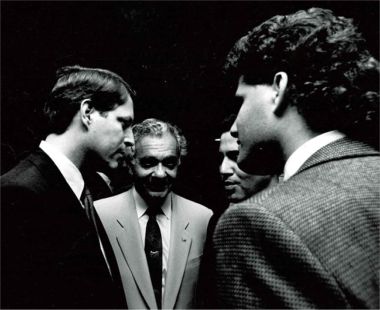
Former
Vice President Al Gore (far left) was
among the prominent figures Pulcrano (far
right)
interviewed as a young reporter. |
"We also had a
10-watt FM radio station at my high school. I covered board of education and borough council meetings, interviewed the governor, met
Secretary of State Kissinger and talked my way into a
Washington party with then-Vice President Ford. Being
where the action is and getting to meet smart people was part of what attracted me to newspapering,"
Pulcrano added.
When
he was 15 years old, Pulcrano's parents moved him and his two
younger sisters to Southern California where he continued
pursuing his passion for media. "I convinced my teachers to let me out of class in the afternoons to write newscasts for the local
AM radio station. I got credit for things like interviewing
California’s then |
| state senate majority leader, George Moscone
about his bill to decriminalize marijuana. How much cooler can you get than that in high
school!?," Pulcrano smiled.
|
|
|
| "I wasn't exactly captain of the football team and dating cheerleaders, you know. (Okay, I was a
nerd.) I finished high school as quickly as I could and enrolled in
San Diego City College’s journalism program,
where the average student was a decade older. I
was 16 and the |
|
journalism adviser kept comparing me to another teen journalist who had been there a
year or two earlier. His name was Cameron Crowe, who was by then working for
Rolling Stone magazine and later wrote and directed the autobiographical
movie Almost Famous," Pulcrano
recalled.
Then
Pulcrano got the first break that would allow him to
turn his favorite pastime into a profession. "The
Reader, which was then a small, struggling weekly in San
Diego, hired me. That was the first time I got paid to do something that I loved so much I would have done it for
free. The following year, I went overseas and studied International Relations and
wrote an early exposé |

Legendary
music industry icon Bill Graham
(left)
chats with young reporter Dan Pulcrano. |
| of nuclear weapons programs in the
Middle East. I returned to go to school at the University of California, Santa
Cruz. A cast of characters ranging from Spaulding
Gray, I.F. Stone and Eugene Ionescu to
Ken Kesey, Allen Ginsberg, Angela
Davis, Jello Biafra and Huey Newton were running around campus then, so there was
a lot to learn and write about!" Pulcrano
said. |
|
"While working in
Santa Barbara on a summer break when I was 19, Jay Levin approached me and asked if I would help him start the
LA Weekly. He was an entrepreneur and journalist who wrote about things that mattered but were
ignored by mainstream media: independent film, punk rock, undiscovered comedians, emerging fashion districts like
Melrose, the secret U.S. war against the Sandinistas. It became the
fastest growing weekly ever launched, and had a transformative effect
not only on Los Angeles, but on major sectors of the entertainment industry and the newspaper publishing industry as well. Working there was
life changing for me too; from that point on I knew what I wanted to
do," Pulcrano declared.
|
Legendary
Rolling Stone publisher Jann Wenner
also inspired Pulcrano. " He nurtured the careers of
Tom Wolfe, Hunter S.Thompson, Annie Liebovitz and others, and even after 40 years, offers some of the most compelling writing about the dangerous idiocy in
D.C. published anywhere," Pulcrano
said." Jann was a founding investor in my publishing group and has remained incredibly supportive through the ups and downs of
transforming it from a print company into a Web publisher at the
epicenter of the Internet revolution,
which has been a fun but hellish 15-year
odyssey."
More
on the "hellish" part (triggered by the web
bubble bursting in 2000) shortly, but long before
reaching that crossroads Pulcrano wrote a business
plan for a publishing company while he was a senior
in college, taking an entrepreneurship course |
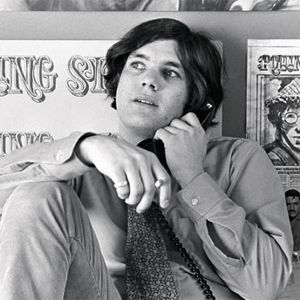
Jann
Wenner, Rolling Stone co-founder
and publisher (1967 photo by Baron Wolman) |
| taught by the fiber optics pioneer
Dr. Narinder Kapany. "That led to starting a community weekly in
Los Gatos, California, where I got to watch legendary entrepreneurs like
Atari's Nolan Bushnell in action during Silicon Valley’s PC and video game
boom," Pulcrano recalled. " Michael D'Addio, who owned
San Jose’s soccer team and an early networking company, helped me understand how computers could share information
and devices when you wired them together." |
|
|
|

An
Internet-boom era copy of Pulcrano's
Silicon Valley weekly Metro |
"Around that time I wrote the business plan for
Metro, an alternative weekly in Silicon
Valley, on an Apple III, using the Visicalc
spreadsheet program. Being in Silicon Valley, we began working with personal
computers and an early electronic mail program, MCI
Mail, back when everyone else was still using typewriters
or dumb terminals, and when "cut-and-paste" editing involved using
scissors and Scotch tape," Pulcrano said.
"We messed around with all the early online services:
Prodigy, Compuserve, AOL. At one point I realized that much of the information that newspapers provided could be delivered more efficiently online. It would be archived, searchable, cheaper and more
current. I knew we were in
trouble. So I went to the board of our trade association in 1993 with a plan to establish a
common effort to develop digital services. They thought I was nuts and booted me off the
board," Pulcrano said. |
However,
as is so often the case, when one door closes another opens -
and that proved true for Pulcrano (who by the way still has a
toe in the print water with his Silicon Valley and Santa Cruz
editions of Metro and a paper called the North
Bay Bohemian). "That year we started Livewire, the
first graphical online service in the weekly industry. It was a dialup service that had all of our articles, as well as free email accounts, live chat and forums. A bookstore sold its books through the service. People
met online and hooked up. Area governments started posting their agendas and minutes. It was Silicon Valley's version of
The Well, and thousands of people in the valley got their first online experiences with
us. In many ways, it was a microcosm for the Web, which caught fire two years
later," Pulcrano said.
From his special vantage point, Pulcrano could now see the
handwriting on the wall. "By 1995 it became clear that the
browser and the World Wide Web was going to squash the early online technologies, so we launched a site and abandoned Livewire and its
successor, Virtual Valley. Like many early web companies, we tried to do it all:
contract website development, our own content services, and, in the late '90s, made some domain investments, which were
premature and made very little business sense. By the bust of 2000, we were overinvested and spread too
thin."
|
The
sudden contraction forced Pulcrano to make a tough
decision, one that went against conventional wisdom at
the time - but one that again proved to be prescient.
" By exploiting email, desktop publishing technologies and networked file sharing, we had grown from one to 11 publications in under a decade and were sharing a common business infrastructure and production department. We had built up a thriving community newspaper group in
the Valley, which I had no choice but to sell." "We also closed down our publications in
San Francisco and Oakland. I made a decision to
concentrate on the Internet and divest from print just at the time
everyone thought the Internet fad was over. Some of
my partners thought I should sell the domains and keep the
newspapers. Luckily I didn't listen,"
Pulcrano said. That
could be the understatement of the year. Pulcrano now
sits pretty while much |

|
| of
the newspaper
business appears to be in an irreversible meltdown. His
good fortune today stems from a series of bold moves he
made when others might have given up and gone
home. |
It
started with scraping up as much money as he could to buy the
domains he owns today (unlike many other holders of
great domains who got their names on the drop or as new
registrants very early in the game, most of Pulcrano's were
purchased on the aftermarket in the mid 90s). "The
first purchase was a number of domains that were owned by a film
director who had produced sequels to Night of the Living
Dead," Pulcrano said. "I
tried to aggregate as many cities as I could after that and
bought others from private owners in the belief that there would
be some economies of scale in managing these as a network.
Although most were purchased for a fraction of today's values,
it was a lot of money at the time, and very risky."
|
Once he had his
hands on the prizes he was after, Pulcrano set about
turning them into something more than just great domain
names. "As the owner of the
majority of the big U.S. cities we feel a responsibility
to make sure these assets realize their potential. Last
year we relaunched our major sites with colorful logos
for each city and a new design. It was a huge |
|

Pulcrano
(center) with some of his team members
at their San Jose office in 2005 after he
had
just purchased the popular city web guide
SFStation.com. Kyu Kyung, head of the
content
and technology team is at far left. |
effort by our content and
technology team, headed by Kyu Kyung, to rebuild
that many sites, and they did an amazing job,"
Pulcrano said.
"Boulevards
also created an automated platform to empower
community-based businesses and event promoters. It allows
them to take control of their digital marketing. They can
market their companies and promote events in an organized
environment where people go for information. In
integrating both time and location-based data, the
Boulevards platform goes beyond one-dimensional
directories and calendaring systems, and as an added
benefit serves the information under a powerful local
brand rather than a national one," Pulcrano said.
|
|
"We are also developing real
estatesystems and a
news channel that will be rolled out on our sites as we
move through this year. We want to add staffing for both
sales and content in each city, but obviously this will
take a lot of investment. Boulevards is a private
company that bootstrapped all this without outside
investment, and we are carefully evaluating what
kind of partner we need to fully realize this
opportunity."
"Obviously we have the virtual
real estate to become a significant media company, along
with the enthusiasm and historical perspective to do so.
We want to do a great job for our communities, since
they are losing an important local institution with the
"reinvention" of daily newspapers, which is
really just disinvestment and managed decline. The local
space is up for grabs right now, and successors
must be conscious of the ways in which media shape and
enrich cities through leadership, a mix of civic
activism and boosterism, economic development and social
responsibility," Pulcrano said. |
While Pulcrano has the world's
strongest collection of large market geodomains, he says that
those who hold small to mid-size city sites face a less
challenging development path. "Big national players generally focus on the top markets and don't drill down into the less populous ones, so there are
more opportunities for entrepreneurs in the small and mid-sized
markets," Pulcrano said. "In a community with a population in the tens of thousand or
low hundreds of thousands, an operator can get to know the key players in a community by walking the commercial districts, joining a service club and hanging out at chamber mixers. If they live in the community, they'll understand the pulse of the
community, develop a passion for it and find out about opportunities first." 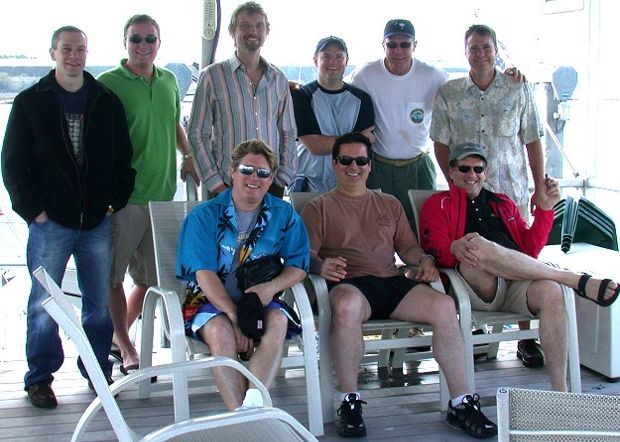
Above:
The founding board members and staff of Associated
Cities (left to right):
Back Row - Josh Metnick,
Patrick Carleton, Sean Miller, Jonathan King,
Skip Hoagland &
Mike Ward. Front Row:
Michael Castello, David Castello and Dan
Pulcrano As
a founding member of Associated
Cities, a trade group for .com geodomain
owners, Pulcrano, who currently serves as the group's chairman,
has been instrumental in helping individual geodomain owners
realize the potential of their properties. Their group has
become a model that other sectors of the domain industry might
do well to emulate. Domain owners have a history of being
"Lone Rangers" but Associated Cities seems to have
cleared that hurdle. I asked Pulcrano how the group has managed
to keep inevitable personal disagreements from sidetracking the
association's goal of pushing the geodomain sector as a whole
forward.
|
|
| "It's entrepreneurial, and the geodomain industry is still in its early stages, so owner-operators tend to
share business practices and develop close personal bonds
that will not be as prevalent when the industry is
consolidated," Pulcrano said. " Also, by only accepting
pure city names with the dotcom suffix, people aren't stepping on one
another's toes too much." |

|
Pulcrano
added, "It’s amazing to me that the venture capitalists, media companies and equity funds haven't yet
woke up and started pouring money into this category because it
really is the last mile of the Internet. The heavy lifting of creating organizations to manage relationships with local businesses and local information will require capital and persistence but the rewards will be
large. The dailies' death spiral is creating a huge
vacuum." "It won't be like the early days of the Internet where a successful vertical play could lop off the most lucrative chunks of a
market," Pulcrano said. "The Internet equivalents of big box stores are fine but the advantage of low cost, highly
personalized communications technology is that it enables the growth of low overhead boutique businesses. Organizations that provide service at the community level will create
tremendous value for their owners. And I think the geodomains are well
positioned to mine this opportunity."
|
|
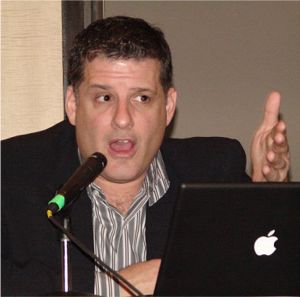
Pulcrano
speaking at DOMAINfest Global
in Hollywood, California (Jan. 2008) |
Pulcrano
was a speaker at last month's DOMAINfest
Global conference in Hollywood,
California. I was there to cover the panel
discussion he was involved in and he had some
particularly interesting things to say about the decline
of newspapers. Though
the Internet is widely perceived to be the force that is
wiping out the papers, Pulcrano said the web was
actually just the final nail in the coffin. He
said their decline actually began decades ago -
and that they have no one to blame for their downfall
but themselves.
"Daily circulation remained flat for
half a century while US population more than doubled,"
Pulcrano said. Big Media consolidated markets and formed joint operating agreements —
legal monopolies — with their competitors, or
informal duopolies that had the same
price-fixing effect. They made obscene |
| profits
by punishing their customers with higher rates, not
by delivering more readers or better value. Their
smugness, arrogance and inability to innovate made them sitting
ducks." |
"Meanwhile community weeklies,
alternative weeklies, business journals, shoppers, city magazines and other
specialty publications started grabbing whole categories of advertising with more
targeted offerings. My newspaper company grew quickly in the 1990s because we concentrated on
offering quality local products and better value to local
businesses," Pulcrano said.
|
"We published both alternative newspapers (free news and entertainment weeklies) around the
Bay Area and community newspapers that were home delivered in Silicon Valley communities like
Los Gatos and Cupertino. Lightweight companies like ours were
gobbling up whole categories. Alternatives grabbed the entertainment franchise, business journals dominated commercial real estate and community weeklies became the preferred vehicle for main
street businesses and local Realtors." "The dailies raised their classified rates and stayed
fat and happy with employment advertising during the great economic boom during the
Clinton years, which made the dailies vulnerable
to Craigslist, a competitor that outperformed them at
low cost in the Bay Area — or for free in other
markets," Pulcrano said. |

Dan
Pulcrano kicking butt and taking names as
the 23-year-old publisher of the Los Gatos
Weekly |
Once
newspapers realized they had a real problem, they tried to pull
the fat out of the fire by going online themselves, but their
efforts were largely ill-conceived and ineffective. Pulcrano
noted "The big newspaper companies invested heavily in online delivery of information early on, but just didn’t deliver a
compelling offering. For example, Knight-Ridder/Dialog had products like
Viewtext, which sold articles. Their web brands — like
Nando, SFGate, AZJournal and SignonSanDiego — were neither musical to the ear nor intuitive."
|
|

Sean
Miller, owner of 'disruptive brand'
NewYorkCity.com (and mate NYC.com) |
"Web nomenclature turned out to be a
great leveler," Pulcrano said. " Sean Miller of
NewYorkCity.com/NYC.com calls geodomains
"disruptive brands." The failure of the newspapers to mine the Internet
opportunity goes beyond vague, klunky names. They presented a digital version of the
19th Century penny press rather than understanding that this was a
new medium that was going to be used in different ways. It was transactional, and a package in
itself." "They thought they could deliver news, sports, business, weather and entertainment
in a book, like before. But the reader had a different
idea. They were going to go to a sports site for sports news, a financial site for stock market intelligence,
and so on. When daily publishers bought a city domain like
Miami.com or Boston.com, they put news on it and organized the information the same way as their print products. And their defensive strategies, designed to protect their golden gooses while they
were feasting on foie gras, ensured that category killers like
Match.com, eBay, |
| Marketwatch,
Google News, Craigslist or Trulia would come from outside the
industry," Pulcrano said. |
|
Wired
Magazine co-founder John Battelle was a
keynote speaker at last month's DOMAINfest Global 2008
conference in California. He emphasized the point that
we began this article with - that domains are media
properties. Battelle urged domain owners to develop
their domain assets with lots of Web 2.0
seasoning sprinkled into the mix - features that allow
visitors to interact with the site and produce
user-generated content. Battelle calls them
"conversational media" sites. Though
it is more labor intensive I believe that if you can add
one more ingredient - unique content from good
writers - you will fare even better. In my mind that is
the surest way to create a special identity for
your site that is hard for someone else to duplicate.
Pulcrano agrees. "Wouldn't it be great if |

Wired
Magazine co-founder John Battelle |
| you
could rely on your readers to create the DN Journal?"
he asked. "While you can get your interviewees to contribute their thoughts and do some of the work,
a good editor has to develop expertise in a subject area and select the topics
that make a content offering compelling. A site that ranks content based on algorhthyms or user popularity won't
push the envelope like one that extends a personality like
Drudge, Salon, Slate, Huffington or
Koz." |
| "Battelle is
right though - the land needs to be developed, because
without content and sales forces, the branding
edge (of a great domain) can turn out to be a transitional
advantage. Remember what happened to the dailies? The
parking phenomenon has created laziness. The less you do with your names, the more you make. The name
"parking" is appropriate, because in cities, land owners found that they could make money by not building anything or even |
|

|
managing
a property. They could tear down an old structure, skin
it with asphalt and put a guy in a tiny booth to put a slip of paper under your wiper blades. Think of how many great cities let their cores be reduced to
skid rows through that monetization scheme. They came
back to life when investors bought the land, swept up the malt liquor cans, hired good architects, placed
high rises on the parking spots and created great spaces for people to live, work, socialize and do business."
"The same has to happen with the Internet real
estate," Pulcrano said. "Otherwise, the public reacts in the same way as a visitor to a downtown that has decayed. The person visits once and
doesn't come back. If you go downtown expecting to see well dressed people, good restaurants and entertainment venues and instead get
empty parking lots with abandoned cars and malt liquor cans, you are not likely to spend time there again." |
Since Pulcrano has such a
great track record for predicting the future, we couldn't help
but ask where he thought our industry is headed from here.
"I have great faith in the future of direct
navigation," Pulcrano said. "As the Internet
matures, more and more people will develop relations with sites
and go directly to them rather than do a new search every time.
The top brands will get stronger and stronger. Over time
the media buyers will understand that there are things more
important than traffic. They have to understand why
people are at a site, not just how many of them are there and
what gender, age and income category describes them." Pulcrano
added "There is a big difference between direct
navigation city guides and media sites. The former have
disproportionately high conversion rates because visitors
are there looking for something specific, often before a trip or
purchase. Newspaper sites have high traffic but much lower
conversions. Among the most hit pages on any newspaper site will
be any article they carry about Britney Spears. What do
you sell to that visitor?" "A
few years ago I noticed that the most visited pages on our
newspapers' websites were articles about selling women's'
panties on Ebay, a photographer who argued that nude
portraits of children were not pornography and the alternative
rock band Good Charlotte. We realized that the newspaper
sites' growth was being enhanced by a global audience of
pedophiles, panty sniffers and young girls who wanted to date
the lead singer of Good Charlotte!" If that doesn't
explain why Pulcrano decided to change horses in the
media race, nothing will.
|
| Pulcrano is obviously a man
with a lot of balls in the air at
the same time. That leads to the kind of long work weeks
entrepreneurs are famous for, but he does manage to
combine business with pleasure whenever he can. "Luckily
I love what I do, so the 80-hour weeks are fun.
I've had some of the best times of my life
hanging out with my Associated Cities friends in places
like Acapulco, Las Vegas, Hilton Head,
Buenos Aires, Los Angeles, San
Francisco, New York and Chicago (where
we spent a night buying drinks for the Bush
twins)," Pulcrano said.
"Besides travel, I like to hike
in the mountains, go deep sea fishing, take road trips,
collect |
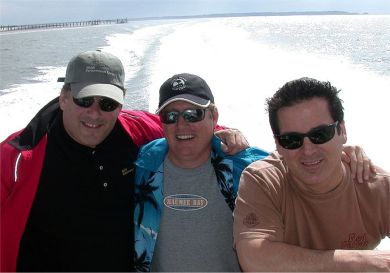
Pulcrano
(left) boating off Hilton Head Island with
friends and fellow Associated Cities board
members
Michael Castello and David Castello (right). |
|
exotic plants and have been
restoring an historic house. I go to clubs and concerts
and museums because I enjoy staying in touch with the
pulse of cities. I'm still single so I don't have family
responsibilities. Right now I'm the vice chair of a city
commission on open government that's drafting San
Jose's first sunshine
law. I write columns and editorials from time
to time and I try to find time for volunteer work in the
community and stay active in Rotary,
because it does great work both locally and around the
world," Pulcrano concluded. |
Many new chapters will undoubtedly be added to
Pulcrano's story in the years ahead. As media consumers continue
to usher old empires to the exit and welcome new ones to center
stage, Pulcrano should be easy to find - just look for the guy
standing in the spotlight.
|










